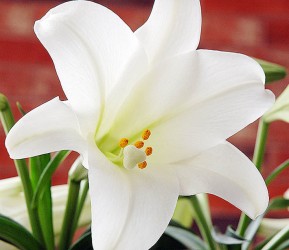Just look at the beautiful flowers in bloom and you can tell it is that time of the year – Easter or Spring as they say in northern climates. All the seeds and bulbs are popping up in full bloom in a rainbow of colours. Lilium longiflorium commonly called Easter lily originated from Japan where it bloom abundantly in the 18th century.
Easter lily has been adopted by many churches as a symbol of the resurrection of Jesus Christ. It is also the emblem of Spring. Each year it puts out its white, elegant trumpet-shaped flowers with a heavenly scent at the end of a distinct green stalk with glossy-green leaves.
 In 1891 Carl Peter an explorer discovered this lily in Japan and sent a few bulbs home to England. Soon these lilies became so popular that it became a world traveller carried by missionaries, soldiers and others from one country to another.
In 1891 Carl Peter an explorer discovered this lily in Japan and sent a few bulbs home to England. Soon these lilies became so popular that it became a world traveller carried by missionaries, soldiers and others from one country to another.
Plant the Easter lily bulb which resembles a head of garlic in well-drained soil in a semi-shaded area in the garden where it would receive bright light, but not direct sunlight. Dig a hole approximately 6 inches deep. Set the bulb so that the neck of the bulb sits on the surface of the soil. Press the soil firmly and water lightly. Remember to keep the soil moist until the bulb starts to grow. Stiff green stems would emerge first.
 Fertilize with Miracle Gro All Purpose or Osmocote Slow Release Plant Food once per month. After the lily has finished blooming, cut off the dry head and let it bloom again.
Fertilize with Miracle Gro All Purpose or Osmocote Slow Release Plant Food once per month. After the lily has finished blooming, cut off the dry head and let it bloom again.
Remember bulbs have a rest period so there is no problem if the bulb goes to sleep. They are also planted as potted plants commercially in the US, where they are forced to bloom for Easter by nurserymen. Elsewhere they bloom during the summer. Bermuda once had major commercial production of the Easter lily, long before the US.
Have a Happy Easter
Until next week, happy gardening!









